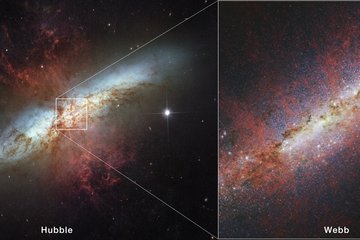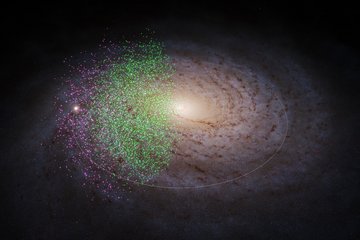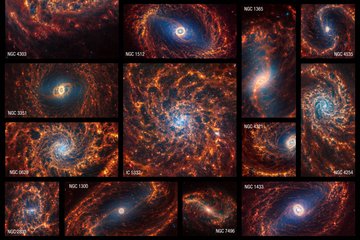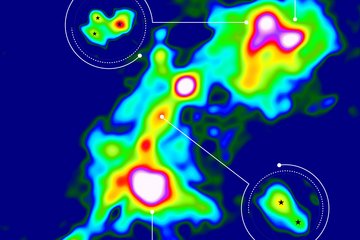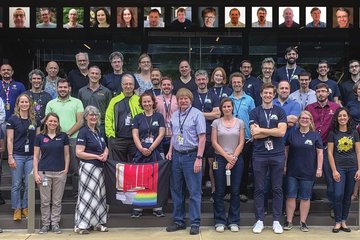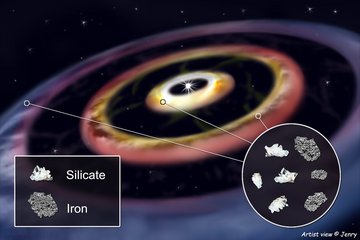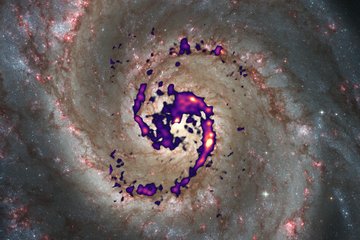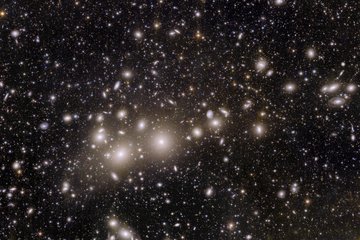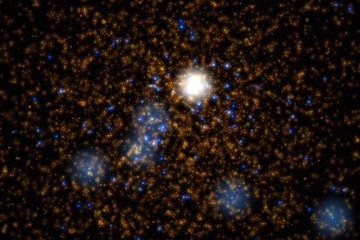Star formation in nearby galaxies under the magnifying glass
New high-resolution observations obtained with ESO’s MUSE instrument complement the PHANGS project’s data collection
A team of astronomers, including Eva Schinnerer from the Max Planck Institute for Astronomy, have released new observations of nearby galaxies that resemble colourful cosmic fireworks. The images, obtained with the European Southern Observatory’s Very Large Telescope (ESO’s VLT), show different components of the galaxies in distinct colours. This new set of data allows astronomers to pinpoint the locations of young stars and the gas they warm up around them. By combining these new observations with data from the Atacama Large Millimeter/submillimeter Array (ALMA), the team is helping to reveal what triggers gas to form stars.
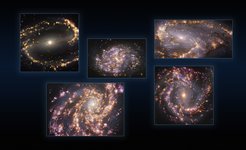
This image combines observations of the nearby galaxies NGC 1300, NGC 1087, NGC 3627 (top, from left to right), NGC 4254 and NGC 4303 (bottom, from left to right) taken with the Multi-Unit Spectroscopic Explorer (MUSE) on ESO’s Very Large Telescope (VLT). Each individual image is a combination of observations conducted at different wavelengths of light to map stellar populations and warm gas. The golden glows mainly correspond to clouds of ionised hydrogen, oxygen and sulphur gas, marking the presence of newly born stars, while the bluish regions in the background reveal the distribution of slightly older stars.
The images were taken as part of the Physics at High Angular resolution in Nearby GalaxieS (PHANGS) project, which is making high-resolution observations of nearby galaxies with telescopes operating across the electromagnetic spectrum.
Astronomers know stars are born in clouds of gas, but what sets off star formation and how galaxies as a whole play into it remains a mystery. To understand this process, a team of researchers has observed various nearby galaxies with powerful ground-based and space-borne telescopes, scanning the different galactic regions involved in stellar births.
“For the first time, we are resolving individual units of star formation over a wide range of locations and environments in a sample that well represents the different types of galaxies,” says Eric Emsellem, an astronomer at ESO in Germany and University of Lyon, France. He is the lead of the VLT-based observations conducted part of the Physics at High Angular resolution in Nearby GalaxieS (PHANGS) project. “We can directly observe the gas that gives birth to stars, we see the young stars themselves, and we witness their evolution through various phases.”
Emsellem and his team have now released their latest set of galactic scans, taken with the Multi-Unit Spectroscopic Explorer (MUSE) instrument on ESO’s VLT in the Atacama Desert in Chile. They used MUSE to trace newborn stars and the warm gas around them, which is illuminated and heated up by the stars and acts as a smoking gun of ongoing star formation.
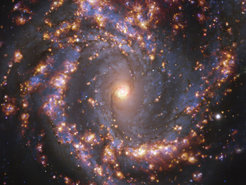
This image, taken by the Multi-Unit Spectroscopic Explorer (MUSE) on ESO’s Very Large Telescope (VLT), shows the nearby galaxy NGC 4303. NGC 4303 is a spiral galaxy, with a bar of stars and gas at its centre, located approximately 55 million light-years from Earth in the constellation Virgo. The image is an overlay of observations conducted at different wavelengths of light to map stellar populations and warm gas. The golden glows mainly correspond to clouds of ionised hydrogen, oxygen and sulphur gas, marking the presence of newly born stars, while the bluish regions in the background reveal the distribution of slightly older stars.
The image was taken as part of the Physics at High Angular resolution in Nearby GalaxieS (PHANGS) project, which is making high-resolution observations of nearby galaxies with telescopes operating across the electromagnetic spectrum
The PHANGS collaboration, led by principal investigator Eva Schinnerer from the Max Planck Institute for Astronomy (MPIA), is combining these new images with observations of the same galaxies taken with ALMA and released earlier this year. ALMA, also located in Chile, is well suited to mapping cold gas clouds — the parts of galaxies that provide the raw material out of which stars form.
MUSE and ALMA complement each other when identifying and examining the starforming regions inside the observed galaxies. “By combining MUSE and ALMA images, we can investigate how earlier stellar generations affect the process of building a new population of stars,” notes Ismael Pessa, a PhD student at MPIA and co-worker in the PHANGS project. “This helps us to better understand what triggers, boosts or suppresses the birth of new stars.” The resulting images are stunning, offering a spectacularly colourful insight into stellar nurseries in our neighbouring galaxies.
“There are many mysteries we want to unravel,” says Kathryn Kreckel from Heidelberg University in Germany and PHANGS team member. “Are stars more often born in specific regions of their host galaxies — and, if so, why? And after stars are born, how does their evolution influence the formation of new generations of stars?”
Astronomers will now be able to answer these questions thanks to the wealth of MUSE and ALMA data the PHANGS team have obtained. MUSE collects spectra — the “bar codes” astronomers scan to unveil the properties and nature of cosmic objects — at every single location within its field of view, thus providing much richer information than traditional instruments. For the PHANGS project, MUSE observed 30,000 nebulae of warm gas and collected about 15 million spectra of different galactic regions. The ALMA observations, on the other hand, allowed astronomers to map around 100,000 cold gas clouds across 90 nearby galaxies, producing an unprecedentedly sharp atlas of stellar nurseries in the close Universe.
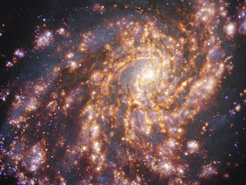
This image of the nearby galaxy NGC 4254 was obtained by combining observations taken with the Multi-Unit Spectroscopic Explorer (MUSE) on ESO’s Very Large Telescope (VLT) and with the Atacama Large Millimeter/submillimeter Array (ALMA), in which ESO is a partner. NGC 4254 is a grand-design spiral galaxy located approximately 45 million light-years from Earth in the constellation Coma Berenices. The image is a combination of observations conducted at different wavelengths of light to map stellar populations and gas. ALMA’s observations are represented in brownish-orange tones and highlight the clouds of cold molecular gas that provide the raw material from which stars form. The MUSE data show up mainly in gold and blue. The bright golden glows map warm clouds of mainly ionised hydrogen, oxygen and sulphur gas, marking the presence of newly born stars, while the bluish regions reveal the distribution of slightly older stars.
The image was taken as part of the Physics at High Angular resolution in Nearby GalaxieS (PHANGS) project, which is making high-resolution observations of nearby galaxies with telescopes operating across the electromagnetic spectrum.
In addition to ALMA and MUSE, the PHANGS project also features observations from the NASA/ESA Hubble Space Telescope. The various observatories were selected to allow the team to scan our galactic neighbours at different wavelengths (visible, near-infrared and radio). Each wavelength range unveils distinct parts of the observed galaxies. Their combination allows the researchers to probe the various stages of stellar birth — from the formation of the stellar birthplaces to the onset of star formation itself and, finally, how the newly born stars eventually destroy their nurseries.
PHANGS offers the first opportunity to assemble such a complete view, taking images sharp enough to see the individual clouds, stars, and nebulae that signify the delivery rooms of stars. “For example, the sharp MUSE images are resolving the impact of the forming stars on its surrounding material. Such a close look helps us understand how stars influence their environments, e.g., by stellar winds,” says postdoctoral researcher Francesco Santoro from MPIA. He adds: “We particularly want to examine how such feedback contributes to the cycling of gas in the interstellar medium, the raw material of stars, and how it affects future generations of stars.”
The work carried out by the PHANGS project will be further honed by upcoming telescopes and instruments, such as NASA’s James Webb Space Telescope. The data obtained in this way will lay further groundwork for observations with ESO’s future Extremely Large Telescope (ELT), which will enable an even more detailed look at the structures of stellar nurseries.
“As amazing as PHANGS is, the resolution of the maps that we produce is just sufficient to identify and separate individual star-forming clouds. However, it’s still not good enough to see what’s happening inside them in detail,” Eva Schinnerer points out. “New observational efforts by our team and others are pushing the boundary in this direction, so we have decades of exciting discoveries ahead of us.”
Background information
The international PHANGS team comprises over 90 scientists ranging from Master students to retirees working at 30 institutions across four continents. The MUSE data reduction working group within PHANGS is being led by Eric Emsellem (European Southern Observatory, Garching, Germany and Centre de Recherche Astrophysique de Lyon, Université de Lyon, ENS de Lyon, Saint-Genis Laval, France). It also includes Francesco Belfiore (INAF Osservatorio Astrofisico di Arcetri, Florence, Italy), Guillermo Blanc (Carnegie Observatories, Pasadena, US), Enrico Congiu (Universidad de Chile, Santiago, Chile and Las Campanas Observatory, Carnegie Institution for Science, Atacama Region, Chile), Brent Groves (The University of Western Australia, Perth, Australia), I-Ting Ho (Max Planck Institute for Astronomy, Heidelberg, Germany [MPIA]), Kathryn Kreckel (Heidelberg University, Heidelberg, Germany), Rebecca McElroy (Sydney Institute for Astronomy, Sydney, Australia), Ismael Pessa (MPIA), Patricia Sanchez-Blazquez (Complutense University of Madrid, Madrid, Spain), Francesco Santoro (MPIA), Fabian Scheuermann (Heidelberg University, Heidelberg, Germany) and Eva Schinnerer (MPIA).
Note: This text is based on the ESO press release that was published at the same time.
MN




